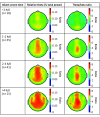Associations Between Infant Screen Use, Electroencephalography Markers, and Cognitive Outcomes
- PMID: 36716016
- PMCID: PMC9887532
- DOI: 10.1001/jamapediatrics.2022.5674
Associations Between Infant Screen Use, Electroencephalography Markers, and Cognitive Outcomes
Abstract
Importance: Research evidence is mounting for the association between infant screen use and negative cognitive outcomes related to attention and executive functions. The nature, timing, and persistence of screen time exposure on neural functions are currently unknown. Electroencephalography (EEG) permits elucidation of the neural correlates associated with cognitive impairments.
Objective: To examine the associations between infant screen time, EEG markers, and school-age cognitive outcomes using mediation analysis with structural equation modeling.
Design, setting, and participants: This prospective maternal-child dyad cohort study included participants from the population-based study Growing Up in Singapore Toward Healthy Outcomes (GUSTO). Pregnant mothers were enrolled in their first trimester from June 2009 through December 2010. A subset of children who completed neurodevelopmental visits at ages 12 months and 9 years had EEG performed at age 18 months. Data were reported from 3 time points at ages 12 months, 18 months, and 9 years. Mediation analyses were used to investigate how neural correlates were involved in the paths from infant screen time to the latent construct of attention and executive functioning. Data for this study were collected from November 2010 to March 2020 and were analyzed between October 2021 and May 2022.
Exposures: Parent-reported screen time at age 12 months.
Main outcomes and measures: Power spectral density from EEG was collected at age 18 months. Child attention and executive functions were measured with teacher-reported questionnaires and objective laboratory-based tasks at age 9 years.
Results: In this sample of 437 children, the mean (SD) age at follow-up was 8.84 (0.07) years, and 227 children (51.9%) were male. The mean (SD) amount of daily screen time at age 12 months was 2.01 (1.86) hours. Screen time at age 12 months contributed to multiple 9-year attention and executive functioning measures (η2, 0.03-0.16; Cohen d, 0.35-0.87). A subset of 157 children had EEG performed at age 18 months; EEG relative theta power and theta/beta ratio at the frontocentral and parietal regions showed a graded correlation with 12-month screen use (r = 0.35-0.37). In the structural equation model accounting for household income, frontocentral and parietal theta/beta ratios partially mediated the association between infant screen time and executive functioning at school age (exposure-mediator β, 0.41; 95% CI, 0.22 to 0.59; mediator-outcome β, -0.38; 95% CI, -0.64 to -0.11), forming an indirect path that accounted for 39.4% of the association.
Conclusions and relevance: In this study, infant screen use was associated with altered cortical EEG activity before age 2 years; the identified EEG markers mediated the association between infant screen time and executive functions. Further efforts are urgently needed to distinguish the direct association of infant screen use compared with family factors that predispose early screen use on executive function impairments.
Conflict of interest statement
Figures


Comment in
-
Long-Term Implications of Using Screen Time to Guide Care.JAMA Pediatr. 2023 Sep 1;177(9):979-980. doi: 10.1001/jamapediatrics.2023.1994. JAMA Pediatr. 2023. PMID: 37399029 No abstract available.

